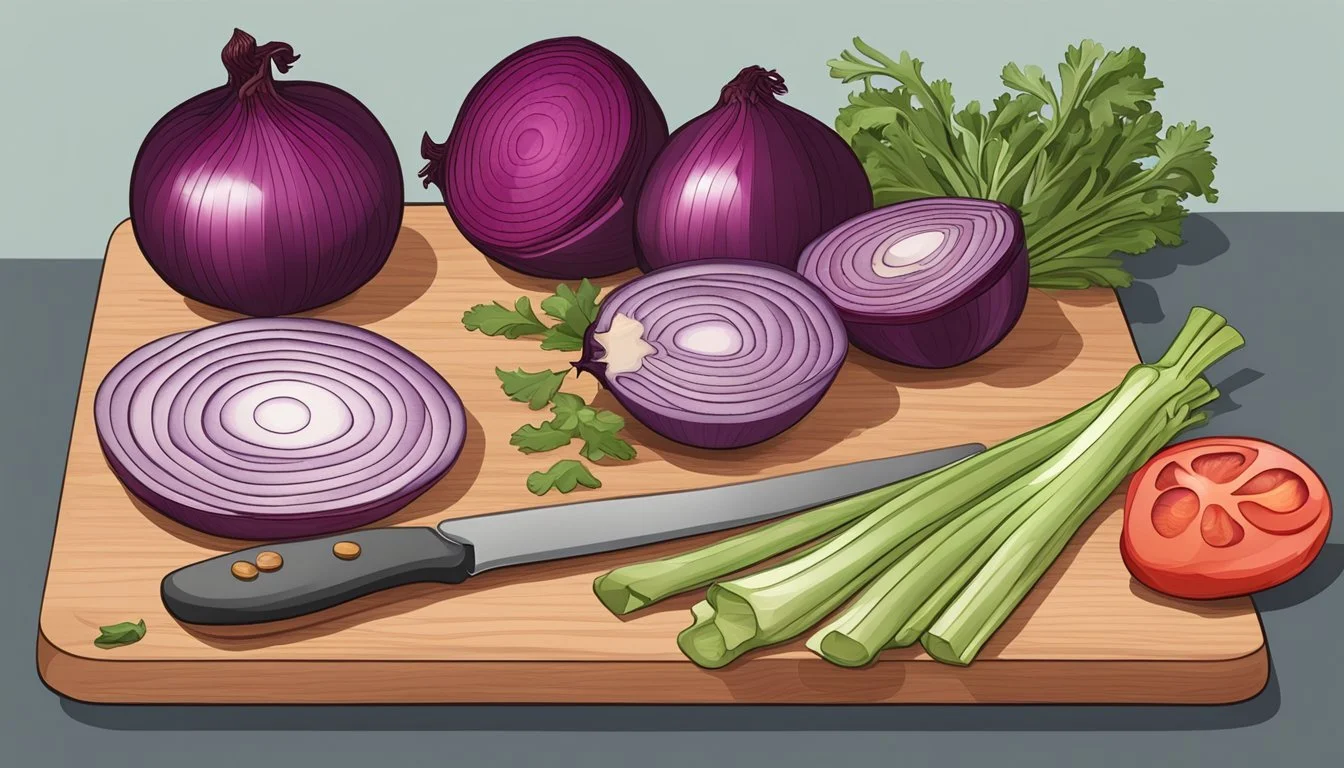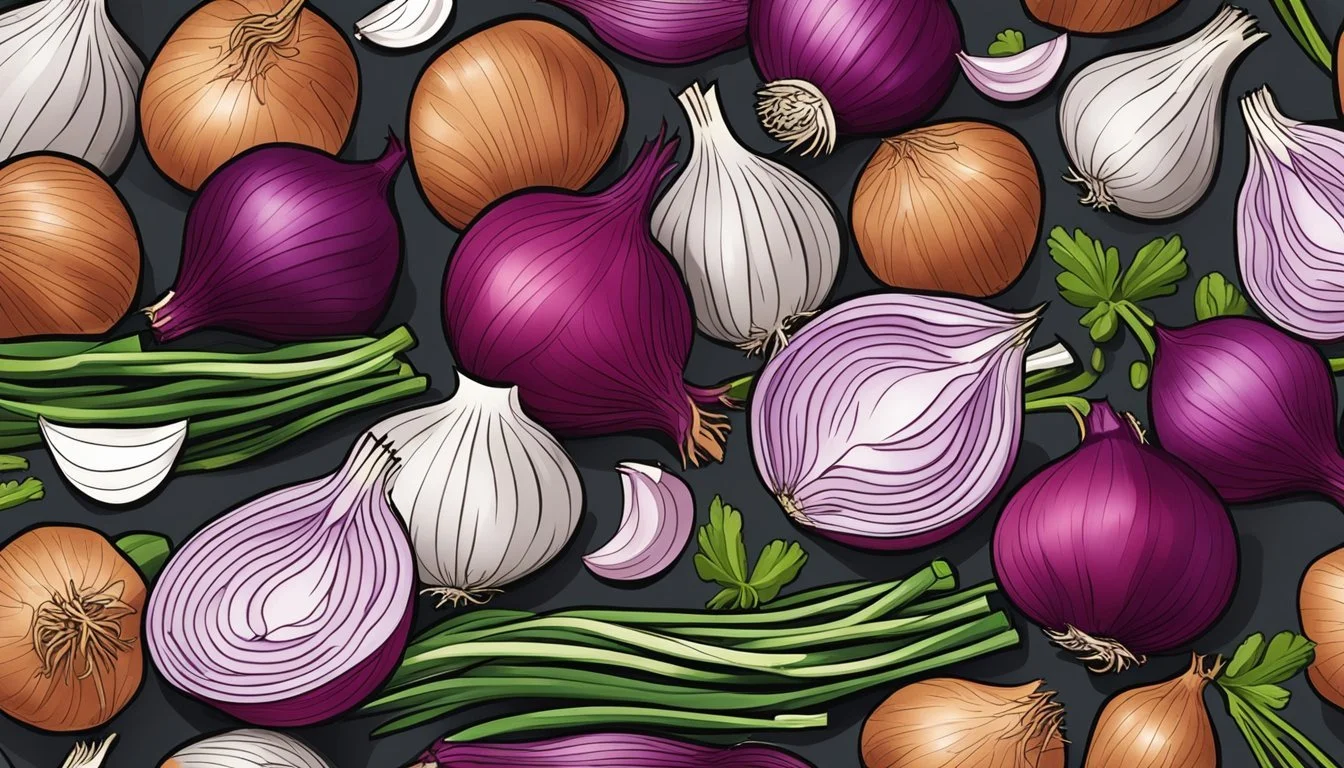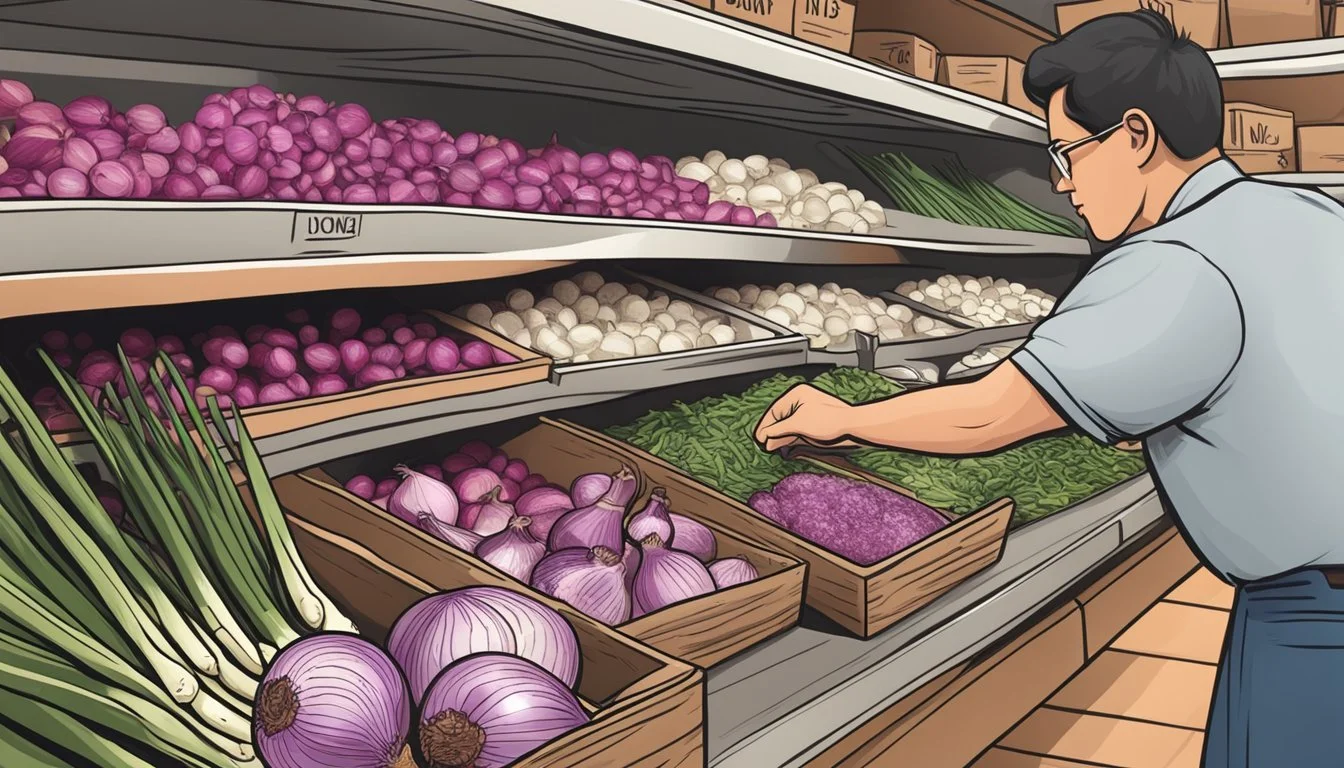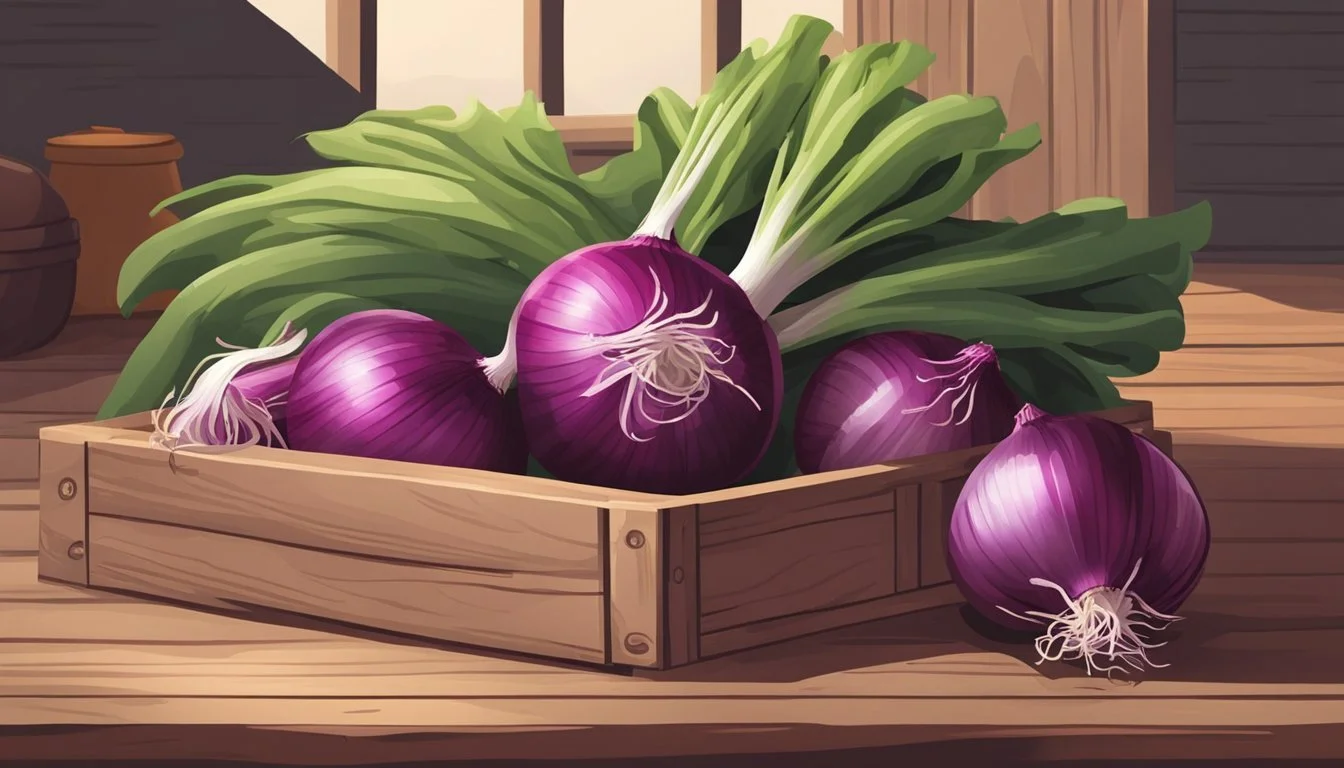Red Onions Substitutes
Best Alternatives for Cooking
Cooking with red onions can add a unique flavor and vibrant color to various dishes. Yet, there are times when this ingredient isn't readily available or suitable for every recipe. A great substitute for red onions includes white onions, which offer a similar texture and taste.
Shallots and green onions are also excellent alternatives that often bring a more delicate flavor profile. They can seamlessly integrate into both raw and cooked dishes. For those looking to maintain the essence of onions without fresh produce, onion powder or dried onion flakes can be utilized effectively.
Exploring different substitutes not only keeps your culinary efforts flexible but can also introduce new and exciting flavors to your meals. From leeks to fennel bulbs, these options provide diversity and adaptability in the kitchen.
Understanding Red Onions
Red onions stand out for their distinct color and strong flavor. They are versatile, used both in raw and cooked dishes, from salads to sautés.
Flavor Profile
Red onions possess a sharp and pungent flavor, more intense than that of yellow or white onions. When eaten raw, they deliver a crisp bite and a spicy kick. Cooking them mellows out their bite, transforming the flavor to be sweet and rich. This makes them suitable for both raw applications in dishes like salsas and sandwiches, as well as in cooked preparations like stir-fries and stews.
Texture and Aroma
The texture of red onions is crisp and firm when fresh. They provide a pleasing crunch in raw dishes, contrasting with the textures of other ingredients. Upon cooking, they soften, becoming tender and translucent. The aroma of red onions is strong and can be somewhat tear-inducing when chopped raw. Cooking them releases a fragrant sweetness, adding depth to the aroma profile of cooked dishes.
Culinary Uses
Red onions are often used in a variety of dishes, both raw and cooked. They are popular in salads for their vibrant color and crunch. When used in salsas, they add a zesty burst of flavor. In sandwiches, their sharpness offers a contrast to other ingredients. Cooking red onions enhances their sweetness, making them ideal for caramelizing, adding to stews, or sautéing with vegetables. Their versatility makes them a staple ingredient in many kitchens.
Common Red Onion Substitutes
When red onions are not available, several varieties of onions and related vegetables can serve as effective substitutes. Each option has its own unique flavor and culinary applications, making some more suitable for certain dishes than others. The following sections will cover some of the most common substitutes in detail.
Yellow Onions
Yellow onions are among the most versatile and commonly used onions in cooking. They can stand in for red onions in almost any recipe due to their robust flavor and good balance of sweetness and acidity. These onions have a papery brown skin and a white to pale yellow interior.
In cooked dishes, yellow onions become sweet and caramelized, making them ideal for soups, stews, and sautés. They can also be used raw, although their taste is sharper compared to red onions. They are a staple in many kitchens and can be found in markets year-round.
White Onions
White onions are distinguished by their white skin and mild flavor. They have a slightly sweeter and less pungent taste than yellow onions, which makes them a suitable replacement for red onions in both raw and cooked applications.
Their crisp and juicy texture works well in salsas, salads, and guacamole. When cooked, white onions become tender and sweet, making them perfect for Mexican cuisine and other dishes where a softer flavor is desired. They can be used in the same quantities as red onions for a balanced flavor profile.
Shallots
Shallots offer a subtle, refined onion flavor with a hint of garlic, making them an excellent substitute for red onions. They are smaller than most onions and have a papery skin that ranges from golden brown to gray.
Shallots are perfect for dishes that benefit from a milder onion presence, such as dressings, sauces, and vinaigrettes. They are also great when roasted or caramelized to bring out their natural sweetness. Because they are less pungent, they can be used in a 1:1 ratio with red onions without overwhelming the dish.
Green Onions and Scallions
Green onions and scallions are young onions harvested before the bulb fully develops. They have a milder taste and can be used both raw and cooked.
The green tops and white bottoms of these onions are perfect for garnishing soups, salads, and stir-fries. They provide a fresh, slightly peppery flavor that complements many dishes. When using green onions as a red onion substitute, consider chopping them finely and adjusting the quantity to match the desired intensity.
Sweet Onions
Sweet onions, such as Vidalia or Walla Walla, have a high sugar content and lower sulfur content, giving them a sweet, mild flavor. Their lack of pungency makes them ideal for raw applications where a gentle onion taste is needed.
They are perfect in salads, sandwiches, and relishes, adding a subtle sweetness without overpowering other ingredients. When cooked, sweet onions become soft and caramelized quickly, making them suitable for roasting or grilling. Use them in dishes where the sweetness will enhance the overall flavor.
Specialty Substitutes
Certain specialty ingredients can effectively replace red onions in various dishes. These substitutes bring unique flavors and textures, making them ideal for diverse culinary applications.
Chives
Chives, with their mild onion-like flavor, are a versatile substitute for red onions. They are particularly suitable for garnishing and adding a subtle onion taste to dishes without overpowering them. Chives are commonly used in salads, soups, and egg dishes. Their delicate texture and bright green color can enhance the visual appeal of meals. Fresh chives should be chopped finely and added toward the end of cooking to preserve their flavor.
Leeks
Leeks belong to the same allium family as red onions and provide a similar but milder taste. They can be used in both raw and cooked forms, making them suitable for soups, stews, and sautés. The white and light green parts of leeks are typically used, while the dark green leaves are often discarded or used for making stock. Their slightly sweet flavor becomes more pronounced when cooked, adding depth to various dishes.
Fennel
Fennel offers a unique flavor profile with a hint of licorice, making it an interesting substitute for red onions. When raw, fennel has a crisp texture and a slightly sweet taste. Cooking fennel softens its texture and mellows its licorice flavor, making it more onion-like. It can be thinly sliced and added to salads or cooked in dishes such as roasts and gratins. Fennel bulbs should be used for a more pronounced flavor.
Celery and Celery Leaves
Celery and its leaves can substitute red onions in recipes where a mild and fresh flavor is desired. Celery provides a crunchy texture and subtle earthiness to dishes. Both the stalks and leaves can be used in various culinary applications, such as salads, stews, and stuffing. Celery leaves, often discarded, should be chopped and used to enhance the flavor and presentation of dishes. They work particularly well as a garnish.
Spring Onions
Spring onions, also known as scallions, are an excellent substitute for red onions due to their similar taste and texture. They can be used raw or cooked and are ideal for recipes requiring a milder onion flavor. The white and green parts of spring onions can be used, with the former offering a sharper taste and the latter a milder one. They are perfect for salads, stir-fries, and garnishes.
Each of these specialty substitutes provides a unique twist to dishes traditionally calling for red onions, allowing for creative culinary exploration and flavor enhancement.
Substitutes for Cooked Dishes
In cooked dishes, certain vegetables can serve as effective substitutes for red onions, providing unique flavors and textures. Specifically, garlic and bell peppers are notable alternatives with distinct culinary advantages.
Garlic
Garlic can infuse cooked dishes with a rich, savory flavor. When used to replace red onions, it offers a robust taste that can complement various ingredients.
Due to its strong flavor, a smaller quantity of garlic is required compared to red onions. Typically, two to three cloves of garlic can substitute for one medium red onion. This makes garlic an efficient choice in soups, stews, and roasted dishes.
Moreover, garlic brings numerous health benefits, such as anti-inflammatory properties and potential cardiovascular advantages. It is versatile and can be minced, crushed, or even roasted whole to deliver different flavor profiles, enhancing the depth of any cooked dish.
Bell Peppers
Bell peppers add a mild, sweet taste and a pleasant crunch when cooked. They can be a colorful and nutritious substitute for red onions in many dishes.
To replace red onions, use an equivalent amount of chopped bell peppers, ensuring a balanced flavor without overpowering other ingredients. Bell peppers work well in stir-fries, casseroles, and sautés, providing not just flavor but also vibrant colors to the meal.
Nutritionally, bell peppers are rich in vitamins A and C and offer a good dose of antioxidants. They are especially effective in enhancing the overall texture and visual appeal of cooked dishes, making them a practical and wholesome alternative to red onions.
Non-Vegetable Alternatives
Non-vegetable substitutes for red onions can offer similar flavors without relying on fresh produce. Two common alternatives are onion powder and onion juice, each providing unique ways to incorporate onion flavor in recipes.
Onion Powder
Onion powder is a versatile and convenient substitute for red onions. It is made from dehydrated ground onions and has a concentrated onion flavor. One teaspoon of onion powder can replace one small onion or around 1/3 cup of chopped fresh onion.
Using onion powder can save preparation time and extend the shelf life of ingredients. It mixes easily into dishes like soups, stews, salad dressings, and marinades. However, it lacks the texture of fresh onions, so consider adding other ingredients like celery or bell peppers to compensate in recipes where texture is important.
Onion Juice
Onion juice provides another practical substitute option. It can be used when a liquid form of onion flavor is preferred or when integrating onion flavor seamlessly into recipes. Onion juice can be purchased or made by blending and straining fresh onions.
This substitute is particularly useful in sauces, dressings, and marinades where the presence of solid onion pieces might be undesirable. It offers a robust and somewhat sweet onion flavor similar to that of fresh onions. For best results, use about one tablespoon of onion juice to replace one small onion in recipes.
These non-vegetable alternatives can be handy in various culinary applications, offering flexibility and convenience while maintaining the desired onion flavor.
Selecting the Right Substitute
Choosing the right substitute for red onions involves understanding the flavor, texture, and recipe requirements. Different substitutes can offer varying degrees of spiciness, sweetness, and crunch that might better suit certain dishes.
Considering Flavor Balance
Red onions are known for their mild spiciness and slight sweetness. When substituting, it's important to find alternatives that can replicate or complement this flavor profile. Shallots, sweet onions, and spring onions are excellent choices due to their subtle sweetness and mildness. Chives and scallions provide a more delicate flavor, suitable for dishes where a less pronounced onion taste is desired.
Example:
Shallots: Mild and sweet, versatile in many recipes.
Sweet onions: Ideal for raw applications like salads.
Scallions: Fresh, delicate flavor for garnishing.
Texture Considerations
The texture of red onions can significantly affect the final dish. Red onions offer a crisp and crunchy texture, especially when raw. For similar texture, fennel and celery can be good substitutes as they maintain crunchiness. Fennel has a slight licorice flavor when raw but transforms closer to an onion-like flavor when cooked. Leeks are another option, though they are milder and softer when cooked.
Example:
Fennel: Crisp and crunchy, works well raw or cooked.
Celery: Maintains crunch in salads and sandwiches.
Leeks: Milder, softer texture suitable for soups and stews.
Recipe-Specific Substitutions
Different recipes call for different qualities in onions. For fresh and raw applications such as salads and sandwiches, green onions and scallions work well due to their mild flavor and crunchy texture. When cooking, white onions, yellow onions, or even leeks can be effective because they caramelize well and develop a sweet and savory flavor. For recipes needing a strong onion flavor without the texture, onion powder or dried onion flakes are convenient choices.
Example:
Green onions: Ideal for fresh dishes and garnishes.
White/yellow onions: Good for sautéing and caramelizing.
Onion powder: Efficient for soups and sauces needing onion flavor without added texture.
Storage and Shelf Life
Proper storage of onion substitutes ensures their freshness and flavor. Red onions and their substitutes can last longer with the right conditions.
Cool, Dark, and Dry Places: Store red onions and substitutes like yellow onions, white onions, and leeks in a cool (45-55°F), dark, and dry place. Areas such as a pantry or cellar are ideal.
Away from Light and Moisture: Light and moisture can lead to mold and sprouting. Keep onions and substitutes in ventilated baskets or mesh bags. Avoid plastic bags as they lack proper ventilation.
Storage in the Refrigerator: For substitutes like chives and scallions, refrigeration is best. Store them in sealed containers to maintain freshness. Cut onions and some substitutes may also be refrigerated but should be used quickly to avoid spoilage.
Freezer Storage: If needed, dice onions and substitutes like green onions can be frozen. Store them in airtight containers or freezer bags. Freezing helps extend the shelf life but may alter the texture slightly.
Alternative Storage Options: Consider storing alternatives like chives in sealed containers in the refrigerator. Each substitute may have specific requirements, so always follow best practices for each type.
Using these storage tips can help maintain the shelf life of red onions and their substitutes, ensuring they remain fresh and ready for use in various recipes.
Creating Your Own Blends
Crafting your own onion substitutes can be both rewarding and handy. Two effective ways to make your substitutes are through home-drying onion flakes and creating a homemade onion spice mix.
Home-Dried Onion Flakes
Home-dried onion flakes offer convenience and a concentrated onion flavor. Start by thinly slicing fresh onions. Spread the slices evenly on a baking sheet lined with parchment paper. Dry them in an oven set at the lowest temperature, ideally around 150°F, for 6 to 8 hours.
Turn the slices midway to ensure even drying. Once completely dried, they should be crisp and brittle. Crush them lightly with your fingers or use a mortar and pestle. Store them in an airtight container away from direct sunlight.
These flakes can be easily added to soups, stews, and sauces, providing a burst of flavor. They offer a quick solution when fresh onions are not available.
Homemade Onion Spice Mix
A homemade onion spice mix blends various spices to mimic the taste of onions. Combine 1 tablespoon of onion powder with 1 teaspoon of garlic powder, 1 teaspoon of ground mustard, and 1/2 teaspoon of celery salt.
Optionally, add a pinch of paprika for extra depth. Mix all ingredients thoroughly in a small bowl. Transfer the blend to a clean, dry spice jar with a secure lid. This mix can substitute for onions in many recipes by adding it during the cooking process.
Use it to season meats, vegetables, or even sprinkle on salads. The homemade mix not only saves time but also ensures you have an onion flavor at hand anytime.
Health Considerations of Onion Substitutes
When substituting red onions, it's essential to consider the nutritional content and potential allergies associated with alternative ingredients. Each substitute offers different health benefits and some may be more suitable for individuals with certain dietary needs.
Nutritional Comparisons
Red onions are rich in antioxidants, vitamins, and minerals. Common substitutes like leeks, celery, and fennel each have their own unique nutrient profiles.
Ingredient Key Nutrients Leeks Vitamins A, C, K, folate Celery Vitamin K, potassium, fiber Fennel Vitamin C, fiber, potassium
Leeks provide vitamins and folate, promoting cellular health. Celery is low in calories and contains fiber, beneficial for digestion. Fennel offers high vitamin C content, supporting immune health. Substitutes like white onions and green onions also provide essential vitamins and minerals, though their profiles may slightly differ from red onions.
Allergy-Friendly Options
Some individuals may experience allergies to specific types of onions or related substitutes. Scallions and leeks are often less allergenic but should still be approached with caution.
For those with celery allergies, substitutes like bell peppers or carrots offer similar health benefits without the allergenic risks. In cases where fresh onions are problematic, dried alternatives such as onion powder or dried onion flakes may be preferable, though these can still pose issues for those with severe allergies.
Understanding these health considerations ensures that substitutions not only match the culinary requirements but also align with individual health needs.







